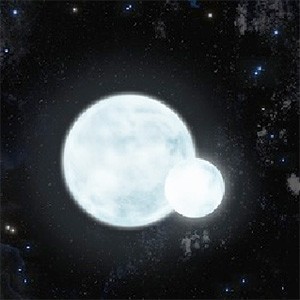Quaking after a collision

Extremely rare survivor of star collision discovered
What happens when two stars that were previously orbiting each other collide? How can such a huge explosion leave more than gas and radiation behind – and in fact even leave both partners intact, albeit in a different form? A team of astronomers1) from Great Britain, Germany and Spain is now hoping to find out what really happens during a stellar collision by examining an oscillating specimen, which is very rare in our galaxy. ‘There is an abundance of data that has told us a lot about the binary star system,’ said Prof. Dr. Ulrich Heber of FAU, who was involved in the analysis. The results were published in the journal Nature on 27 June 20132).
The researchers were actually searching for extrasolar planets when they caught sight of the exotic star. Project leader Dr. Pierre Maxted and his colleagues then decided to use one of the European Southern Observatory’s (ESO) high-speed cameras in Chile3). This led to the discovery that the brightness is fluctuating in a unique way, caused by the star’s oscillating. This is the first time such a thing has been proven in a celestial body of this kind.
This lends credence to the collision hypothesis, which says that a momentous collision can occur in a binary star system if one of the partners inflates to a red giant. Our sun is facing a similar fate: its radius will grow more than hundredfold when its supply of hydrogen, the current nuclear fuel, runs out. But unlike many other stars, it was not born as a twin. As soon as one of the siblings reaches the giant star phase in its life cycle, collisions between the expanded star and its smaller companion can occur. This cannot be compared with the collision of two rocks, however: the orbit of the secondary star, now surrounded and slowed down by the inflated shell, becomes ever smaller until a massive release of energy explodes away up to 90 percent of the red giant’s mass. Computer simulations predict that the remaining star has not only become very light, but that it now has highly unusual characteristics.
Unfortunately such stars are rare, which is why the team of astronomers was thrilled to discover this misfit. The footage from the high-speed camera ULTRACAM showed tiny fluctuations in brightness. They are caused by sonic waves spreading through the star’s interior. Such pulsations can be found in our sun as well as many other stars and undergo regular cycles. In our sun and in the new fluctuating star, such a cycle is about five minutes long. The sonic waves penetrate deep into the star’s interior, almost to its centre. Similar to how seismic waves can be used to explore the Earth’s interior, the internal structure of the star can be sounded out using the appropriate physical-numeric computer models. This requires more accurate measurements, which the team plans on carrying out at the European Southern Observatory.
‘We have even been able to weigh the two stars,’ said Prof. Dr. Ulrich Heber. ‘What we found out was that one of them is much too light – a clear indicator of its companion tearing away the majority of its mass in a collision. Now we can find out why stars even survive such collisions.’
Further information on the new star, an audio clip and an animated visualisation can be found at www.astro.keele.ac.uk
1) The discovery team consist of: Dr. Pierre Maxted (project leader) and Dr. Barry Smalley (Keele University, UK); Dr. Aldo Serenelli (CSIC-IECC, Spain); Andrea Miglio (University of Birmingham, UK); Prof. Thomas Marsh and Dr. Elmé Breedt (University of Warwick, UK), Prof. Ulrich Heber and Veronika Schaffenroth (University of Erlangen-Nürnberg), Prof. Vikram Dhillon and Dr. Stuart Littlefair (University of Sheffield, UK), Dr. Chris Copperwheat (Liverpool John Moores University, UK)
2) DOI: 10.1038/nature12192
3) The British high-speed camera ULTRACAM at the 3.6-metre New Technology Telescope at the European Southern Observatory (ESO). ULTRACAM website: http://www.vikdhillon.staff.shef.ac.uk/ultracam
Further information:
Prof. Dr. Ulrich Heber
Phone: +49 (0)951 9522214
heber@sternwarte.uni-erlangen.de